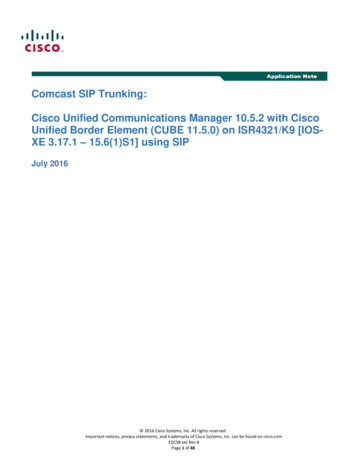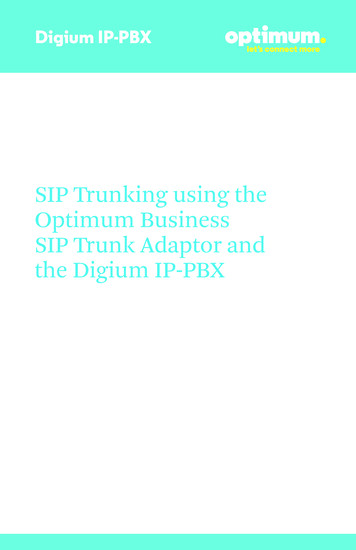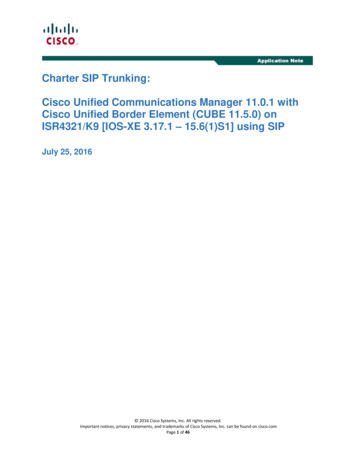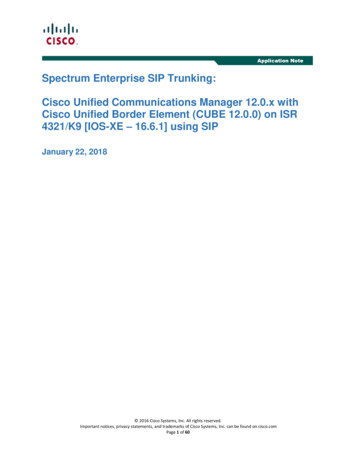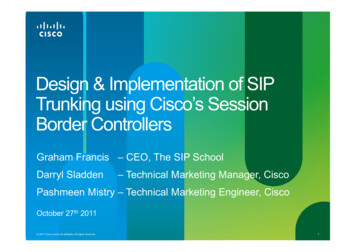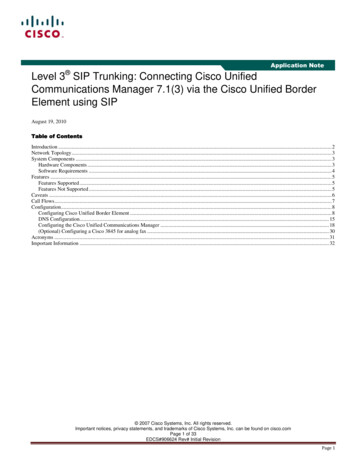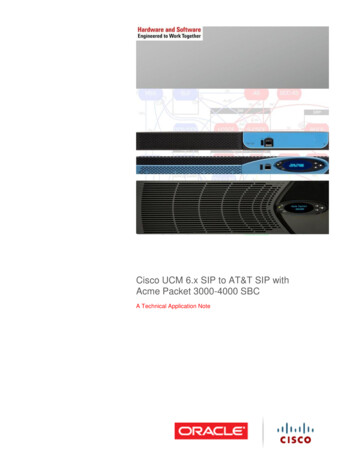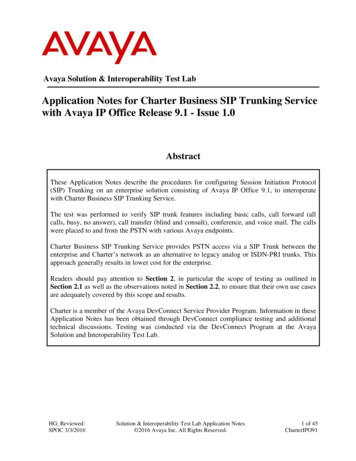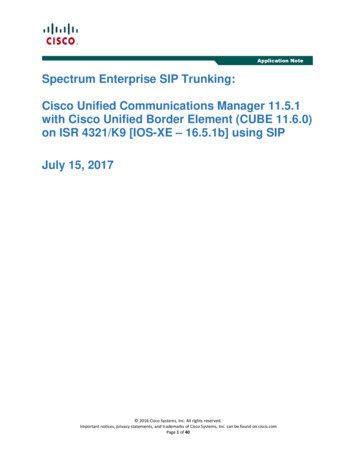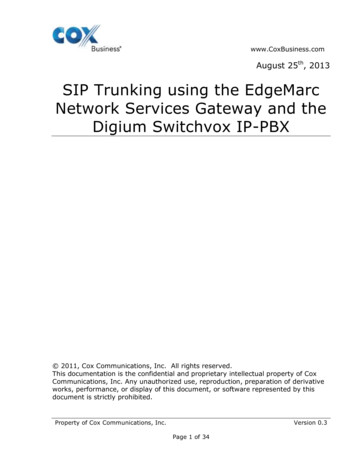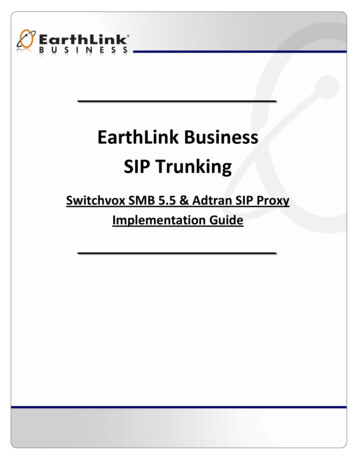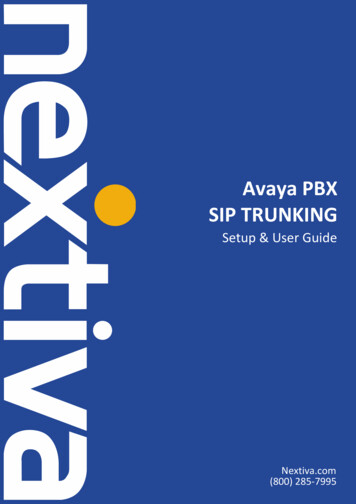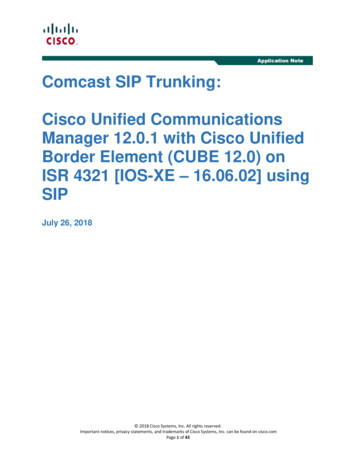
Transcription
Comcast SIP Trunking:Cisco Unified CommunicationsManager 12.0.1 with Cisco UnifiedBorder Element (CUBE 12.0) onISR 4321 [IOS-XE – 16.06.02] usingSIPJuly 26, 2018 2018 Cisco Systems, Inc. All rights reserved.Important notices, privacy statements, and trademarks of Cisco Systems, Inc. can be found on cisco.comPage 1 of 43
Table of ContentsIntroduction. 4Network Topology . 5System Components . 6Hardware Requirements . 6Software Requirements . 6Features . 6Features Supported . 6Features Not Supported . 6Caveats . 6Configuration . 7Configuring Cisco Unified Border Element . 7Network Interface . 7Global Cisco UBE Settings . 8Media Passing through Cisco UBE (media flow-through vs. media flow-around). 9Codecs . 9Dial Peer . 9Call Flow . 11Configuration Example . 13Configuring Cisco Unified Communications Manager . 28Cisco UCM Version . 28Cisco Call Manager Service Parameters. 28Offnet Calls via Comcast SIP Trunk . 29Dial Plan. 37Acronyms . 41Important Information. 42 2018 Cisco Systems, Inc. All rights reserved.Important notices, privacy statements, and trademarks of Cisco Systems, Inc. can be found on cisco.comPage 2 of 43
Table of FiguresFigure 1: Network Topology . 5Figure 2: Outbound Voice Call . 11Figure 3: Inbound Voice Call . 11Figure 4: Outbound Fax Call . 12Figure 5: Inbound Fax Call . 12Figure 6: PBX to PBX via Comcast Call . 12Figure 7: Cisco UCM Version . 28Figure 8: Service Parameters. 28Figure 9: SIP Trunk Security Profile . 29Figure 10: SIP Profile. 30Figure 11: SIP Profile (Cont.) . 31Figure 12: SIP Profile (Cont.) . 32Figure 13: SIP Trunks List . 33Figure 14: SIP Trunk to Cisco UBE . 34Figure 15: SIP Trunk to Cisco UBE (cont.) . 35Figure 16: SIP Trunk to Cisco UBE (Cont.). 36Figure 17: Route Patterns List . 37Figure 18: Route Pattern for Voice . 38Figure 19: Route Pattern for Voice (Cont.) . 39Figure 20: Route Pattern for Fax . 40 2018 Cisco Systems, Inc. All rights reserved.Important notices, privacy statements, and trademarks of Cisco Systems, Inc. can be found on cisco.comPage 3 of 43
IntroductionService Providers today, such as Comcast, are offering alternative methods to connect to the PSTN viatheir IP network. Most of these services utilize SIP as the primary signaling method and centralized IP toTDM POP gateways to provide on-net and off-net services.Comcast is a service provider offering that allows connection to the PSTN and may offer the endcustomer a viable alternative to traditional PSTN connectivity. A demarcation device between theseservices and customer owned services is recommended. As an intermediary device between CiscoUnified Communications Manager and Comcast network, Cisco Unified Border Element (Cisco UBE) ISR4321/K9 running IOS-XE 16.06.02 can be used. The Cisco Unified Border Element 12.0 providesdemarcation, security, interworking and session control services for Cisco Unified CommunicationsManager 12.0.1 connected to Comcast IP network.This document assumes the reader is knowledgeable with the terminology and configuration of CiscoUCM (Cisco Unified Communications Manager). Only configuration settings specifically required forComcast interoperability are presented. Feature configuration and most importantly the dial plan arecustomer specific and need individual approach. This application note describes how to configure a Cisco Unified Communications Manager (CiscoUCM) 12.0.1 and Cisco Unified Border Element (Cisco UBE) on ISR 4321/K9 [IOS-XE – 16.06.02]for connectivity to Comcast SIP Trunking service. The deployment model covered in this applicationnote is CPE (Cisco UCM 12.0.1) to PSTN (Comcast). Testing was performed in accordance to Comcast generic SIP Trunking test methodology andamong features verified were – basic calls, DTMF transport, Music on Hold (MOH), unattended andattended transfers, call forward, conferences and interoperability with Cisco Unity Connection(CUC) The Cisco UCM configuration detailed in this document is based on a lab environment with asimple dial-plan used to ensure proper interoperability between Comcast SIP network and CiscoUnified Communications. The configuration described in this document details the importantconfiguration settings to have enabled for interoperability to be successful and care must be takenby the network administrator deploying Cisco UCM to interoperate to Comcast SIP Trunkingnetwork.This application note does not cover the use of Calling Search Spaces (CSS) or partitions on Cisco UCM.To understand and learn how to apply CSS and partitions refer to the cisco.com link below:http://www.cisco.com/c/en/us/td/docs/voice ip comm/cucm/srnd/collab10/collab10/dialplan.html 2018 Cisco Systems, Inc. All rights reserved.Important notices, privacy statements, and trademarks of Cisco Systems, Inc. can be found on cisco.comPage 4 of 43
Network TopologyFigure 1: Network Topology Cisco IP Phones 7942, 9951 and 9971 phones are the devices primarily used throughout the testingto place or receive callsVentaFax Soft Client is used to perform all fax related scenarios. The fax client is connected to SIPGateway (Cisco ATA) via FXS port which in turn communicates with Cisco UCM over SIP. 2018 Cisco Systems, Inc. All rights reserved.Important notices, privacy statements, and trademarks of Cisco Systems, Inc. can be found on cisco.comPage 5 of 43
System ComponentsHardware Requirements Cisco UCS-C240-M3S VMWare host running ESXi 5.5 StandardCisco ISR 4321/K9 router as CUBECisco ATA SPA112IP phones 9951 (SIP), 9971 (SIP) and 7942 (SCCP)Comcast(Adtran) ESG – Provided and managed by ComcastSoftware Requirements Cisco Unified Communications Manager 12.0.1Cisco Unity Connection 12.0.1IOS-XE 16.06.02 for ISR 4321/K9 Cisco Unified Border ElementFirmware Version 1.3.5 (004p) for Cisco ATA SPA112Comcast(Adtran) ESG R11.4.3.V – Provided and managed by ComcastFeaturesFeatures Supported Incoming and outgoing off-net calls using G711ULawCall holdCall transfer (unattended and attended)Call forward (all, busy and no answer)Calling Line (number) Identification Presentation (CLIP)Calling Line (number) Identification Restriction (CLIR)DTMF (RFC2833)Media flow-through on Cisco UBEFax (G.711 pass-through)Features Not Supported Cisco IP phones used in this test do not support blind transferComcast does not support Fax with SIP serviceCaveats CLID is not updated on PSTN phones for transfer (attended and unattended) OffNet PSTNscenarios. Caller ID is not updated at PSTN once transfer is completed by PBX. Cisco UBEmodify PAI/PPI header and forward to network in the tested release. CISCO BUG ID:CSCuv04539.For testing, 911 calls were routed internally in the Comcast lab. 2018 Cisco Systems, Inc. All rights reserved.Important notices, privacy statements, and trademarks of Cisco Systems, Inc. can be found on cisco.comPage 6 of 43
ConfigurationConfiguring Cisco Unified Border ElementNetwork InterfaceConfigure Ethernet IP address and sub interface. The IP address and VLAN encapsulation used are forillustration only, the actual IP address can vary. For SIP trunks two IP addresses must be configured - forLAN and WAN.interface GigabitEthernet0/0/0description ComcastCube WANip address 192.65.79.134 255.255.255.128shutdownmedia-type rj45negotiation autoredundancy rii 15redundancy group 1 ip 192.65.79.185 exclusive!interface GigabitEthernet0/0/1description ComcastCube LANip address 10.80.18.48 255.255.255.0negotiation autoredundancy rii 16redundancy group 1 ip 10.80.18.50 exclusive!! 2018 Cisco Systems, Inc. All rights reserved.Important notices, privacy statements, and trademarks of Cisco Systems, Inc. can be found on cisco.comPage 7 of 43
Global Cisco UBE SettingsIn order to enable Cisco UBE IP2IP gateway functionality, enter the following:!!voice service voipno ip address trusted authenticateaddress-hidingmode border-element license capacity 20allow-connections sip to sipredundancy-group 1no supplementary-service sip refersupplementary-service media-renegotiatesipsession refreshasserted-id paiprivacy pstnmidcall-signaling passthrug729 nections sip to sipAllow IP2IP connections between two SIP call legsfax protocolSpecifies the fax protocolasserted-idSpecifies the type of privacy header in the outgoing SIP requests andresponse messagesmidcall-signaling passthruPasses SIP messages from one IP leg to another IP leg 2018 Cisco Systems, Inc. All rights reserved.Important notices, privacy statements, and trademarks of Cisco Systems, Inc. can be found on cisco.comPage 8 of 43
Media Passing through Cisco UBE (media flow-through vs. media flow-around)Default Cisco UBE configuration enables Cisco UBE to work in flow-through mode (this test uses the flowthrough mode). In order to enable flow-around mode, perform the following actions:voice service voipmedia flow-aroundCodecsG711ulaw is used as the preferred codec for this testing.voice class codec 1codec preference 1 g711ulawcodec preference 2 g729r8!Dial PeerCisco UBE uses dial-peers to route the call accordingly based on the digits!dial-peer voice 100 voipdescription Outbound from CUCM to CUBE LANsession protocol sipv2session transport udpincoming called-number .Tvoice-class codec 1voice-class sip bind control source-interface GigabitEthernet0/0/1voice-class sip bind media source-interface GigabitEthernet0/0/1dtmf-relay rtp-ntefax protocol pass-through g711ulawno vad!dial-peer voice 101 voipdescription Outbound from CUBE WAN to Adtrandestination-pattern .Tsession protocol sipv2session target ipv4:10.64.3.115 2018 Cisco Systems, Inc. All rights reserved.Important notices, privacy statements, and trademarks of Cisco Systems, Inc. can be found on cisco.comPage 9 of 43
session transport udpvoice-class codec 1voice-class sip bind control source-interface GigabitEthernet0/0/0voice-class sip bind media source-interface GigabitEthernet0/0/0dtmf-relay rtp-ntefax protocol pass-through g711ulawno vad!dial-peer voice 102 voipdescription Incoming from Adtran to CUBE WANsession protocol sipv2incoming called-number 856333.voice-class codec 1voice-class sip bind control source-interface GigabitEthernet0/0/0voice-class sip bind media source-interface GigabitEthernet0/0/0dtmf-relay rtp-ntefax protocol pass-through g711ulawno vad!dial-peer voice 103 voipdescription Incoming from CUBE LAN to CUCMdestination-pattern 856333.session protocol sipv2session target ipv4:10.80.10.2voice-class codec 1voice-class sip bind control source-interface GigabitEthernet0/0/1voice-class sip bind media source-interface GigabitEthernet0/0/1dtmf-relay rtp-ntefax protocol pass-through g711ulawno vad! 2018 Cisco Systems, Inc. All rights reserved.Important notices, privacy statements, and trademarks of Cisco Systems, Inc. can be found on cisco.comPage 10 of 43
Call FlowIn the sample configuration presented here, Cisco UCM is provisioned with four-digit directory numberscorresponding to the last four DID digits. No digit manipulation is performed on the Cisco UBE.For incoming PSTN calls, the Cisco UBE presents the full ten-digit DID number to Cisco UCM. The CiscoUCM picks up the last 4 significant Digits configured under SIP Trunk and routes the call based on those 4digits. Voice calls are routed to IP phones; Fax calls are routed via a 4-digit route pattern over a SIP trunkthat terminates on the Fax Gateway and in turn to the VentaFax client connected to the Fax Gateway.CPE callers make outbound PSTN calls by dialing a “9” prefix followed by the destination number. Foroutbound fax calls from the analog fax endpoint, Cisco fax Gateway sends to Cisco UCM the DID withleading access code “9”. A “9.@” route pattern strips the prefix and routes the call with the remaining digitsvia a SIP trunk terminating on the Cisco UBE for Voice call or Fax. For PBX to PBX via Comcast, Callerdial 9 prefix followed by the target 1 10-digits number, 9 was stripped and the remaining digits were sendto Cisco UBE, Cisco UBE pass the DID under Dial Peer 101 and send to Comcast network which will directback to Cisco UBE and handled same as normal incoming PSTN call.Figure 2: Outbound Voice CallFigure 3: Inbound Voice Call 2018 Cisco Systems, Inc. All rights reserved.Important notices, privacy statements, and trademarks of Cisco Systems, Inc. can be found on cisco.comPage 11 of 43
Figure 4: Outbound Fax CallFigure 5: Inbound Fax CallFigure 6: PBX to PBX via Comcast Call 2018 Cisco Systems, Inc. All rights reserved.Important notices, privacy statements, and trademarks of Cisco Systems, Inc. can be found on cisco.comPage 12 of 43
Configuration ExampleThe following configuration snippet contains a sample configuration of Cisco UBE with all parametersmentioned previouslyActive Cisco UBEComcastCube1 enPassword:ComcastCube1#show running-config!version 16.6service timestamps debug datetime msecservice timestamps log datetime msecplatform qfp utilization monitor load 80no platform punt-keepalive disable-kernel-core!hostname ComcastCube1!boot-start-markerboot system flash r!vrf definition Mgmt-intf!address-family ipv4exit-address-family!address-family ipv6exit-address-family!no logging queue-limitlogging buffered 10000000 2018 Cisco Systems, Inc. All rights reserved.Important notices, privacy statements, and trademarks of Cisco Systems, Inc. can be found on cisco.comPage 13 of 43
no logging rate-limitno logging monitorenable secret 5 1!aaa new-model!aaa session-id common!multilink bundle-name authenticated!voice service voipno ip address trusted authenticateaddress-hidingmode border-element license capacity 20allow-connections sip to sipredundancy-group 1no supplementary-service sip refersupplementary-service media-renegotiatesipsession refreshasserted-id paiprivacy pstnmidcall-signaling passthrug729 annexb-all!voice class codec 1codec preference 1 g711ulawcodec preference 2 g729r8!license udi pid ISR4321/K9 sn FDO19244MQ8diagnostic bootup level minimal 2018 Cisco Systems, Inc. All rights reserved.Important notices, privacy statements, and trademarks of Cisco Systems, Inc. can be found on cisco.comPage 14 of 43
spanning-tree extend system-id!!redundancymode noneapplication redundancygroup 1name b2bHAcomcastpriority 100 failover threshold 75timers delay 30 reload 60control GigabitEthernet0/1/0 protocol 1data GigabitEthernet0/1/0track 1 shutdowntrack 2 shutdown!track 1 interface GigabitEthernet0/0/0 line-protocol!track 2 interface GigabitEthernet0/0/1 line-protocol!!interface GigabitEthernet0/0/0description ComcastCube WANip address 192.65.79.134 255.255.255.128shutdownmedia-type rj45negotiation autoredundancy rii 15redundancy group 1 ip 192.65.79.185 exclusive!interface GigabitEthernet0/0/1description ComcastCube LAN 2018 Cisco Systems, Inc. All rights reserved.Important notices, privacy statements, and tradem
for connectivity to Comcast SIP Trunking service. The deployment model covered in this application note is CPE (Cisco UCM 12.0.1) to PSTN (Comcast). Testing was performed in accordance to Comcast generic SIP Trunking test methodology and among features verified were – basic calls, DTMF transport, Music on Hold (MOH), unattended andFile Size: 2MBPage Count: 43People also search forbandwidth sip trunkcomcast sip servicecomcast sip settings
